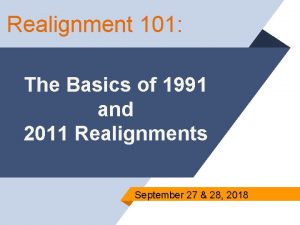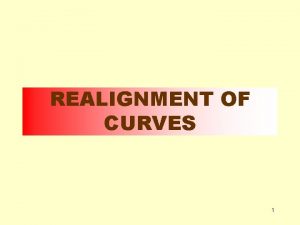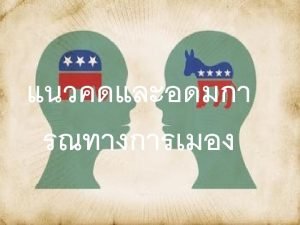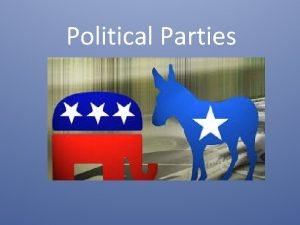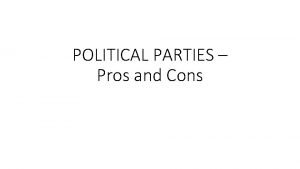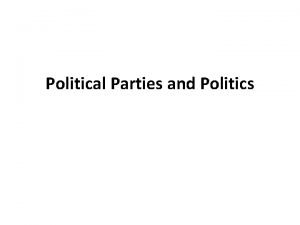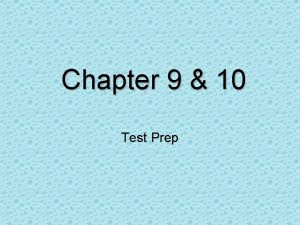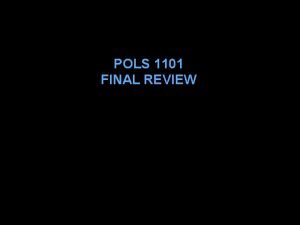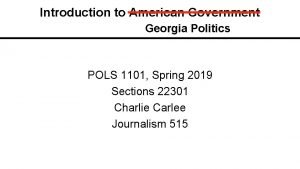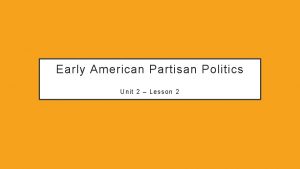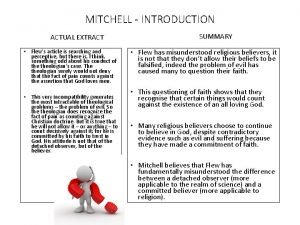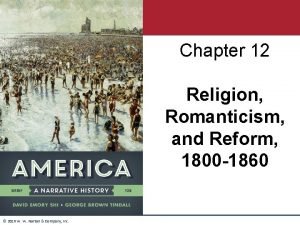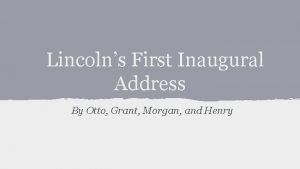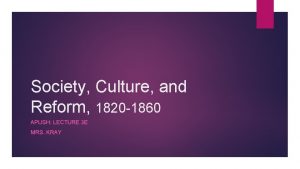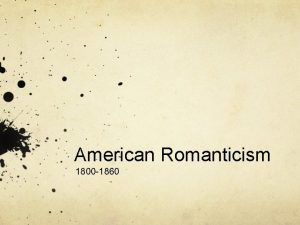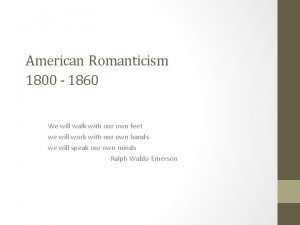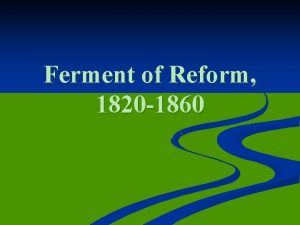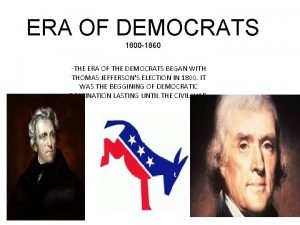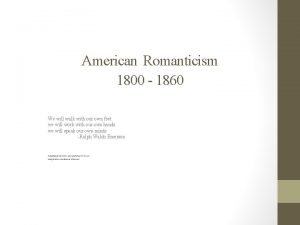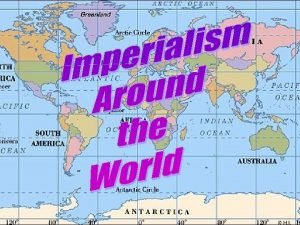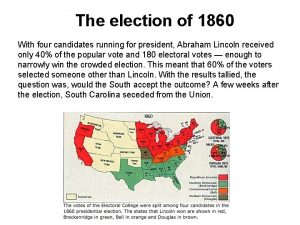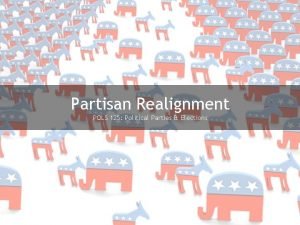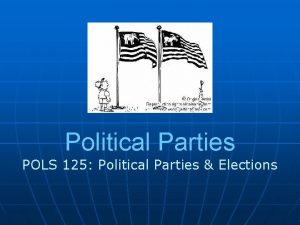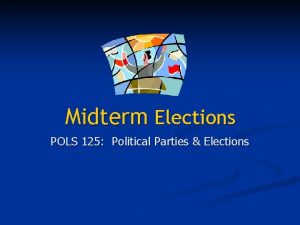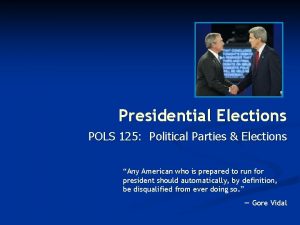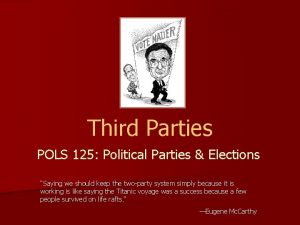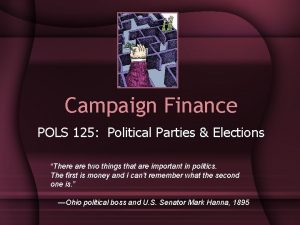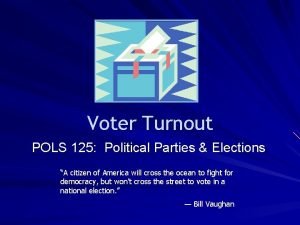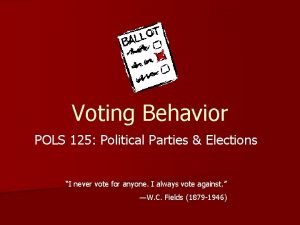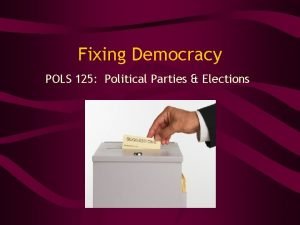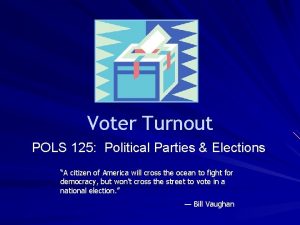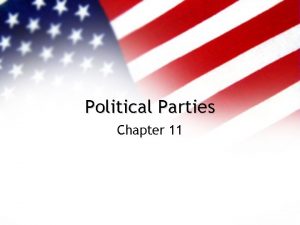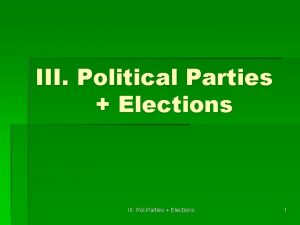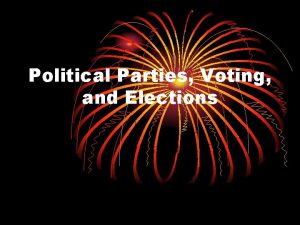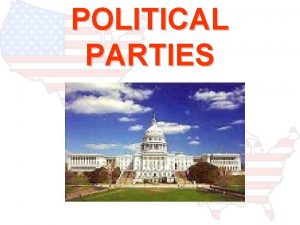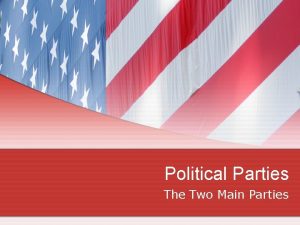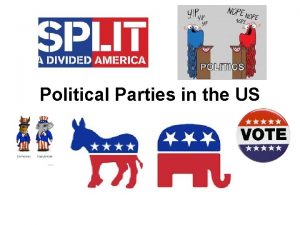Partisan Realignment POLS 125 Political Parties Elections 1860






























![Potential Realignment: 2008? …[T]he view that 2008 marks a historic realignment is favor of Potential Realignment: 2008? …[T]he view that 2008 marks a historic realignment is favor of](https://slidetodoc.com/presentation_image/2bf08c248ab5679369fb0ec930a8a15b/image-31.jpg)


- Slides: 33

Partisan Realignment POLS 125: Political Parties & Elections

1860 “The election, so far as the City and State of New-York are concerned, will probably stand, hereafter as one of the most remarkable in the political contests of the country; marked, as it is, by far the heaviest popular vote ever cast in the City, and by the sweeping, and almost uniform Republican majorities in the country. ” —The New York Times November 7, 1860

“We had quite a line at the election. I never knew New York City to go against the Democrats before, but they got a good scare this time. I don’t believe we will be bothered with any more silver bills or boy orators for some time. ” —Charles C. King New Brighton, New York November 29, 1896

“A Sharp Right Turn: Republicans and Democrats Alike See New Era in 80 s Returns” —The Washington Post, November 6, 1980

1994 “Tsunami is the Japanese word for ‘great wave caused by underwater seismic shock. ’ What was the shock that caused the conservative wave of 1994? No inchoate choler at incumbents; not lust for change’s sake; not negative advertising used by both sides; not solely disappointment with the character or personality of Bill Clinton. The quake was caused by the majority’s belief that government is growing too big, intrusive, domineering and remote—and wasteful of tax dollars at all levels…” —William Safire, November 10, 1994

The Vocabulary of Realignments • • Critical election Realigning era Party system Periodicity

Realignment Theory Critical election Realigning era Party system

Realignment Theory • American national elections can be sorted into two kinds: realigning and nonrealigning • These elections fall into patterns (e. g. , periodicity) • Oscillation in and out of the cycle takes roughly 30 years • Oscillation is caused by a strengthening and weakening of party identification • Voter turnout is unusually high in realigning elections

Realignment Theory • Third parties tend to form • A new issue, or cluster of issues, replaces the old • There is an increase in ideological polarization • Realignments are associated with major changes in government policy • Realignments bring on long spans of unified government • Voters express themselves “effectively and consequentially” during electoral realignments, but not otherwise

Mayhew calls this a “grand, even magnificent interpretative structure…” but is it true?

Classic Realignments: 1860

1860 Old line of party cleavage WHIG PARTY Anti-Slavery North DEMOCRATIC PARTY REPUBLICAN PARTY Northern Democrats Southern Whigs DEMOCRATIC PARTY New line of party cleavage Pro-Slavery South

Classic Realignments: 1896

Classic Realignments: 1932

The Periodicity of Realignments Notice how these “critical elections” occurred with regular frequency—every 30 -40 years. Why? Because of generational change: • 1 st generation: Their party identity is forged in crisis. They are likely to have a strong and emotional commitment to a political party that will last the remainder of their lives. • 2 nd generation: Children of the realignment generation may follow their parents’ party affiliation, but with less intensity and determination. • 3 rd generation: These are children of “normal” politics. Having grown up during a period of stability, their party allegiance is weak.

Like Waiting for Godot… If generational change makes realignment possible, and if our last realignment was in 1932, why haven’t we experienced a critical election since then? Theory suggests that we are “ripe” for a realignment… • 1968: War in Vietnam, Civil Rights movement, Johnson’s “Great Society” • 1980: Reduction in government spending and taxation, expansion of national defense • 1994: Partisan shift in the balance of power in Congress favoring the Republican Party • 2000 -2008: A secular realignment into “Red” and “Blue” states? ? ?

The phrase “red state, blue state” was voted the Word of the Year in 2004 by the American Dialect Society.

2008 election results by state

2008 election results, by county

2008 election results cartogram, adjusted for population

The 49 Percent Nation In 2001, Michael Barone wrote a now famous essay titled “The 49 Percent Nation. ” In it he argues that there are now two Americas, almost evenly divided, split by geography, as well as social, religious and cultural differences. • BLUE STATES: Metropolitan, educated, black, Northeastern, Rust belt, West. • RED STATES: Rural and suburban, religious, South and Midwest. God-fearing and gun-loving.



The Two Americas What divides us? GEOGRAPHY – As Barone points out, Democratic candidates do well in the Northeast, in “Rust Belt” states, and on the west coast, especially in densely populated urban areas where Clinton’s “personal peccadilloes raised few hackles. ” Meanwhile, Republicans thrive in the rural and suburban South and Midwest. RELIGION - According to Barone “…the two Americas apparent in the 48 percent to 48 percent 2000 election are nations of different faiths. One is observant, tradition-minded, moralistic. The other is unobservant, liberationminded, relativistic. ”

A Comparison of Red State and Blue State Voters, 2004 RED STATE VOTERS BLUE STATE VOTERS DIFFERENCE Protestant 69% 41% +28% Catholic 16% 35% -19% Jewish, other, none 15% 24% -9% Weekly or more 54% 34% +20% Seldom, never 32% 53% -21% GUN OWNING HOUSEHOLD 53% 22% +29% PRO-CHOICE ON ABORTION 46% 69% -23% OPPOSE GAY MARRIAGE OR CIVIL UNIONS 51% 26% +25% APPROVE OF IRAQ WAR 60% 45% +15% VOTED FOR BUSH 60% 44% +16% RELIGION CHURCH ATTENDANCE

Purple America Today, Barone says we are a 51 percent nation, given Bush’s 51 -48 victory over John Kerry in 2004. But “Red” and “Blue” state designations can be misleading given the narrow margins by which some states are won. A better approach shows variations of degree. Should we use this map to criticize the Electoral College’s winner-takeall approach?

Purple America In this 3 D version of the “purple America” map, height represents voter density (e. g. , voters per square mile). “It was almost as if two different Americas were voting…” —Michael Barone, 2001

Purple America cartogram, 2004

What’s Next? How long can a near 50/50 split in the electorate last without a clear break in one direction or the other? Did we finally see that break in 2008? • • External events Shifting demographics Ideological positioning Candidate charisma

Is breaking the 50/50 split really what we want? Is it what is best for the country? As columnists David Broder and Dan Balz note “The partisan wars have severely limited Washington’s ability to accomplish big things. ”
![Potential Realignment 2008 The view that 2008 marks a historic realignment is favor of Potential Realignment: 2008? …[T]he view that 2008 marks a historic realignment is favor of](https://slidetodoc.com/presentation_image/2bf08c248ab5679369fb0ec930a8a15b/image-31.jpg)
Potential Realignment: 2008? …[T]he view that 2008 marks a historic realignment is favor of the Democrats is misleading—or at least premature. Obama’s victory offers no guarantee of a realignment. It is only an opportunity to bring one about. ” —Paul Starr

2008 Election Results by State

Here's how America has changed in 4 years:
 1991 realignment
1991 realignment Apex distance of curve
Apex distance of curve Wikimedia
Wikimedia Political parties
Political parties Political parties
Political parties Political parties
Political parties Political parties pros and cons
Political parties pros and cons Brainpop voting
Brainpop voting A political party is an association of
A political party is an association of The spoils system made political parties more powerful by
The spoils system made political parties more powerful by Pols 1101 final exam
Pols 1101 final exam Nadi di kaki namanya
Nadi di kaki namanya Steunverband pols
Steunverband pols Uga pols 1101
Uga pols 1101 Antony flew theology and falsification
Antony flew theology and falsification Lesson 2 partisan politics
Lesson 2 partisan politics Basil mitchell parable of the partisan
Basil mitchell parable of the partisan Partisan symbol
Partisan symbol Basil mitchell parable of the partisan
Basil mitchell parable of the partisan Chapter 12 religion romanticism and reform
Chapter 12 religion romanticism and reform Border states in 1860
Border states in 1860 Election of 1860 pie chart
Election of 1860 pie chart Apush 1820 to 1860
Apush 1820 to 1860 American romanticism 1800 to 1860 worksheet answers
American romanticism 1800 to 1860 worksheet answers American romanticism 1800 to 1860 worksheet answers
American romanticism 1800 to 1860 worksheet answers Daniel hess aspirateur
Daniel hess aspirateur American reform movements between 1820 and 1860
American reform movements between 1820 and 1860 Era of the democrats 1800-1860
Era of the democrats 1800-1860 Values feeling and intuition over reason
Values feeling and intuition over reason South carolina 1860
South carolina 1860 Romantic period in american literature
Romantic period in american literature South africa 1860
South africa 1860 Decreto 1860 de 1994
Decreto 1860 de 1994 Map of 1860
Map of 1860
